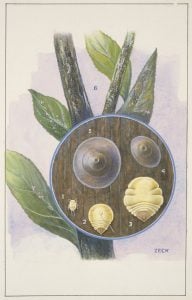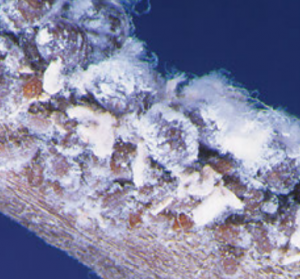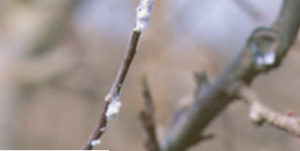Pruning is an opportunity to monitor for diseases and pests so you are ahead of the game later in the season. Take a moment to educate your pruning staff to look for evidence of key pests and diseases while they are working among your trees. Watch out for:
- ERM and Bryobia infestations
- San Jose Scale
- Wood rotting fungi
- Woolly aphid
- Snails
Record the location and provide workers with some flagging tape to mark the affected trees, so you can follow up at the appropriate time in the season.
European Red Mite (ERM) and Bryobia Mite infestations
Winter is a good time to look for the tiny dormant red eggs on the bark of branches and spurs – look close to the buds. ERM eggs are onion shaped and Bryobia are round (you will need a hand lens).
A good monitoring method to use is the 1 minute inspection/tree (download the IPDM monitoring sheet here). Choose 5 trees in a block and spend 1 minute looking at each tree. Write down how many trees are infested, noting the date and location for future use.

Overwintering European Red Mite eggs are often found clustered around the base of branches (Photo: NSW DPI)

European Red Mite eggs overwinter on bark near buds. Note their ‘onion’ shape which differentiates them from the round red Bryobia eggs (Photo: Agriculture Victoria)
San Jose Scale
San Jose scale is an insect that secretes a hard scale that when lifted off reveals a lemon-yellow soft bodied flat round sucking insect. The scale is greyish, roughly circular with a central or offset darker “nipple”.
The best place to look for scale is in sheltered spots such as in the forks or branches or in tiny cracks and crevices in the bark, or between the bud and stem of younger branches. Even older, established scale colonies can be difficult to detect due to a camouflage effect.
Focus on areas of previous infestations and trees with twigs or limbs showing poor vigour or decline/ death. Use a one-minute/tree sampling method and count the number of infested trees you find (download the IPDM monitoring sheet here).
Removal of infested wood will help control the scale. Burn all infested prunings.
Mark infested trees for follow-up monitoring in spring. Apply a dormant oil spray in late July-early August in infested blocks (for more information see Australian Apple and Pear IPM manual). See Pest Pocket Guide (page 65) for more images.

Overwintering San Jose Scale (Photo: NSW DPI)

San Jose Scale life stages (Photo: NSW DPI)
Woolly apple aphid
Mark and document infested trees with fluffy white colonies. Focus your monitoring around pruning cuts and broken limbs.
In winter, most woolly aphid colonies will be on the roots but some will still be on the aerial parts of the tree. These aerial colonies do not produce as much of the white wool commonly seen in summer. As colonies decline and lose their wool, galls (or woody outgrowths or lumps on the branches) become apparent.

Woolly aphid colony on twig. Adults covered in white wax threads (Photo: Agriculture Victoria)

Woolly aphids on twig (Photo: Agriculture Victoria)
Snails
Monitor for snails on the ground, especially in sheltered spots under dense vegetation, or in tree guards.
Snail eggs often survive through winter in moist soil under fallen leaves. Ground sprays of urea assist leaves to breakdown quickly, eliminating moist refuges. For further information on Snails see article Autumn Snail Control.
Wood rotting fungi
Wood rotting fungi attack trees under stress, entering through wounds caused by pruning, grafting and sunburn. The fungus grows into the heartwood causing discolouration and dieback. Affected branches show browning and papering of the outer bark, loss of vigour, woodrotting and death.
Within a year or two of infection brackets are seen forming on dead wood, particularly during autumn and winter.
While monitoring, note limbs showing fungal fruiting bodies (bracket or shelf fungus). If pruning these limbs you need to cut well below the infected area and sterilise secateurs between cuts. Use a pruning wound sealant to protect large pruning cuts from infection by wood rotting fungal spores.

Wood rotting fungi fruiting bodies (shelf or bracket fungi) on tree trunk (Photo: Agriculture Victoria)
Reference: Orchard Pest and Disease Handbook (2000-2002)
Reviewed by David Williams (Agriculture Victoria) and Kevin Dodds (NSW DPI)
